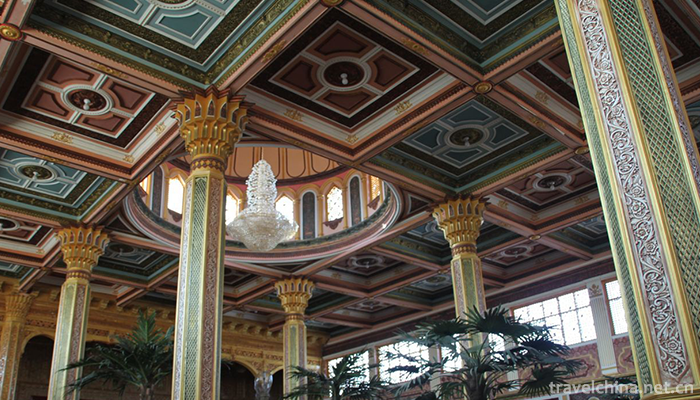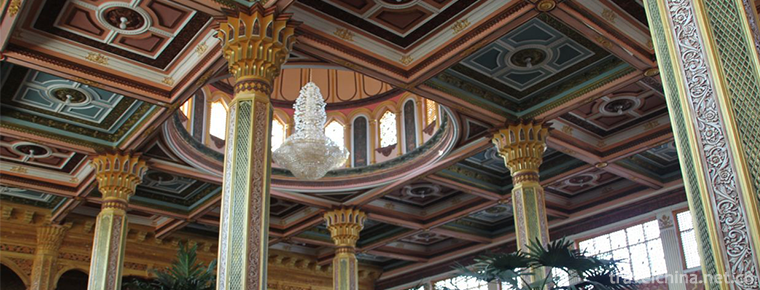Uygur Residential Architecture Skills Aiwan Sailai Residential Construction Skills
Uygur Residential Architecture Skills Aiwan Sailai Residential Construction Skills
Declaration area or unit: Hetian area, Xinjiang Uygur Autonomous Region
Uygur Aiwan Sailai dwellings are mainly distributed in towns and villages along the desert edge of the Tarim Basin, especially in Yutian, Moyu, Minfeng, Pishan, Hetian, Shache and Kashgar along the southern edge of the Tarim Basin desert.
Aiwan Sailai is a typical Uygur residential building form in Hetian. Aiwan refers to a square building with bright and ventilated meanings in the middle of the roof. Sailai refers to the living room or the place where guests are entertained in this kind of building. The whole building is called Aiwan Sailai.
The space in Aiwan is generally divided into two parts: the open courtyard space and the enclosed living room space. Aiwan is a closed, atrium-style layout. The living space consists of living rooms, dining rooms, back rooms, storage rooms, showers and other small rooms. The front rooms facing the courtyard are mostly equipped with external corridors, and the bottom corridors are mostly equipped with solid and non-heating kangs, namely "bundle covers", for sitting outdoors. Aiwangsai has no clear central axis, the layout of the plane is very flexible, the courtyard and building area is not fixed, can be large or small, according to population and economic conditions.
In the aspect of architectural decoration, Hetian Aywang mostly adopts the method of contrast between the real and the virtual, and mainly adorns. Gallery eaves paintings, mostly mosaic tiles, wood carvings and window edge decorations, mostly flowers and plants or geometric figures. Its decoration is mainly in the portico, Aiwang side windows and other parts, mainly wood carving, exquisite carving.
Uygur Aywan Sailai residential building construction techniques are mainly handed down by teachers, all of them are male, there is no written record, and handed down from generation to generation by oral and heart-to-heart teaching methods. With the popularization and popularization of modern residential building forms, the number of experienced folk craftsmen has decreased, and the traditional Aywan Saili residential building technology is in an endangered situation.


-
2.Rabbit head
Rabbit head is a traditional snack in Sichuan Chengdu, Shanxi Datong and Zhejiang Quzhou.
Time 2018-10-13 -
3.Ali Mountain
Mount Alishan, located 75 km east of Jiayi City, Taiwan Province, is located at an altitude of 2,216 meters. Its coordinates are 23 degrees north and 31 minutes east
Time 2018-10-30 -
4.barbecued porkTime 2018-11-02
-
5.Xian City Wall Scenic Area
Xi'an City Wall Scenic Area and National AAAAA Tourist Scenic Area are the four-in-one Scenic Area around the city with the theme of the ancient city wall of Xi'an, including the moat
Time 2018-12-12 -
6.Lion Mountain Scenic Area
Lion Mountain Scenic Area is located in the east of Shaoshan Scenic Area, which is divided into Lion Mountain Scenic Area and Benbenling Scenic Area.
Time 2019-02-08 -
7.Nanchong Xishan Scenic Area
Nanchong Xishan Scenic Spot, located in the west of Shunqing City, is a provincial scenic spot and a national 4A-level tourist attraction. It is the destination of "Three Kingdoms Cultural Explor
Time 2019-02-25 -
8.Eight treasures tomato
Blanch the tomatoes with boiling water, peel them off, dig a round piece along the pedicle one week, remove the seeds and wash them. Cut all the accessories into small dices, mix shrimps and meat with
Time 2019-03-25 -
9.Violin Opera
Violin opera, originally a flower-drum opera in Yueyang, Hunan Province, spread to Chongyang, Tongcheng and other places around the end of the Qing Dynasty and renamed "Violin Opera", is a u
Time 2019-06-19 -
10.Panzhihua before Sui Dynasty
Archaeological discoveries have proved that Panzhihua is one of the areas where human activities took place earlier. In addition to the "Yuanmou Man" and "Butterfly Man" relics found in nearby areas, the huilongdong ancient human site about 18000-12000 years ago has been found in Panzhihua City.
Time 2020-12-14 -
11.Neijiang cultural undertakings
By the end of 2019, there are 121 performing arts venues in Neijiang City, including 6 cultural venues. There are 5 museums, 5 cultural relics protection and management institutions, 7 national key cultural relics protection units, 42 provincial cultural relics
Time 2020-12-16 -
12.Yibin cultural undertakings
By the end of 2019, there are 7 art performance groups, 2 art performance venues, 11 cultural centers, 186 cultural stations and 10 public libraries in Yibin cultural system. There are 1 provincial science and technology tourism demonstration base, 2 prov
Time 2020-12-18